Zwift Ride: Indoor training brand's re-entry into hardware market is absolutely not what we were expecting
Yep, Zwift Ride has been resurrected. It’s now an entry-level indoor smart bike that’s inexpensive to buy, simple to use and easy to live with. A disappointment for seasoned Zwifties perhaps, but a potential delight for newbies.


When, just a few weeks back, Zwift surprised me with an invite to preview a secret piece of hardware my imagination ran wild. What could it be? My initial reaction, based on the demise of the original Zwift Ride smart bike back in 2022, as well as its relatively recent legal run-in with Wahoo was ‘wow, I thought Zwift was through with hardware’. That spat culminated in a slap on the wrist for patent infringement and the speedy withdrawal of its Zwift Hub One trainer, a piece of kit so new the orange paint was barely dry. Ouch!
Then I remembered Zwift’s equally recent, but genius Play controllers that offer responsive, real-time control of the platform from your handlebars. Of course, that’s it - Zwift’s a tech company, so this launch is certain to be a truly advanced chunk of gaming ’n training wizardry. Right?
I couldn’t have been more wrong. In many ways, Zwift Ride is the least sophisticated piece of kit to ever feature the Zwift logo, bar its box set of colourful sweat towels. Nevertheless, it’s an impressive piece of product development that has the potential to disrupt the indoor smart bike market. Let me explain why.
Zwift Ride 2.0
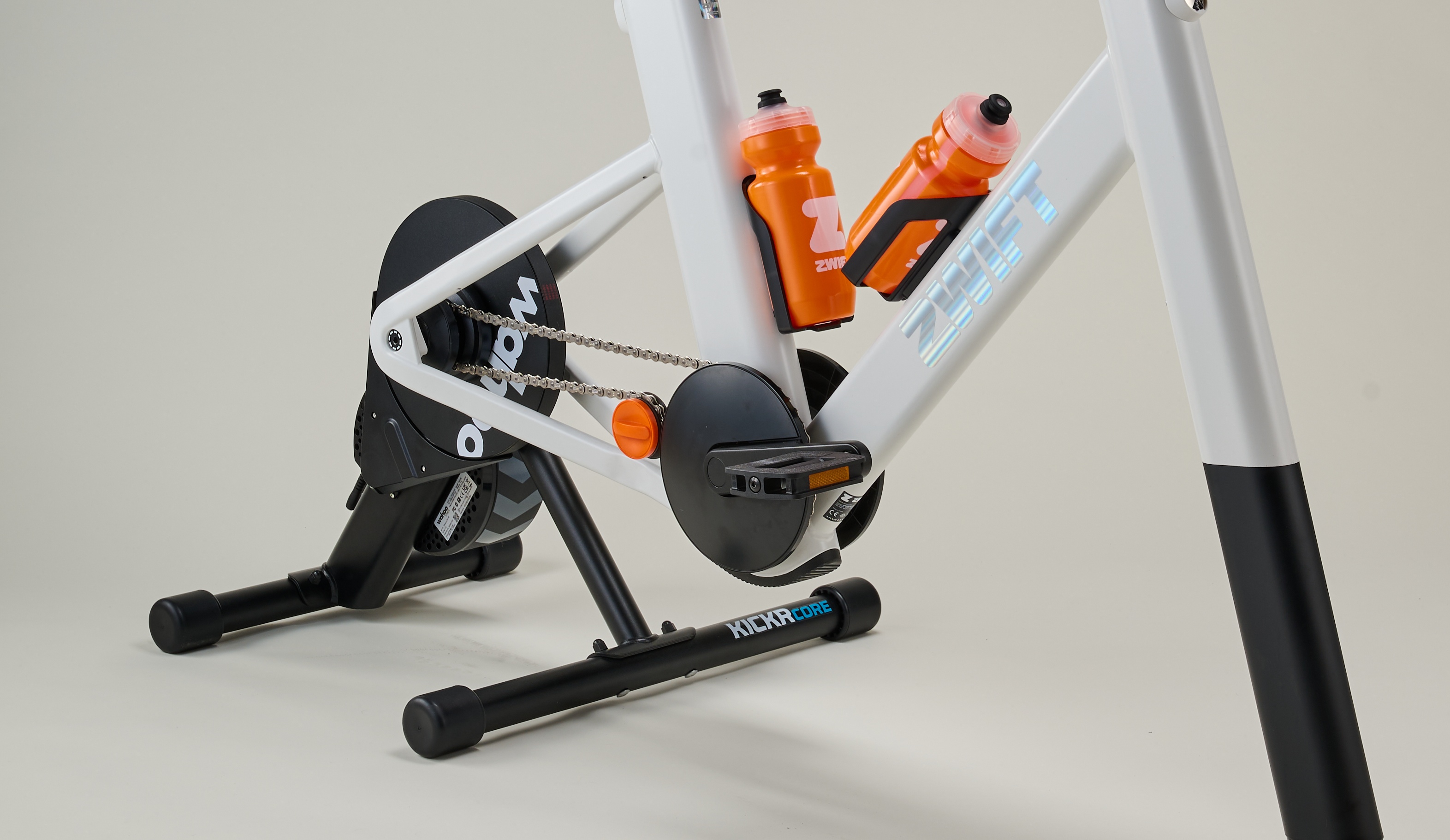
The Zwift Ride design makes use of the Wahoo Kickr Core
Zwift Ride is now an entry-level indoor smart bike that the brand unashamedly says is priced as cheaply as possible. On that premise, it could have been awful, but having spent the last few weeks spinning away on one in my front room every evening I’m happy to report that it’s not. For a smart bike, the concept is actually, well, very clever.
Before Zwift pulled the plug, the original 2022 version was rumoured to be a high-tech marvel with glowing wheels and an aspirational price tag, but this latest product is far from that. So, why has Zwift suddenly surprised us with a new Ride?
Zwift is in the business of signing up subscribers but it recognises that common barriers to entry include the cost, complexity and appearance of the hardware required before you can take your first virtual pedal stroke. At one extreme, you can just about get away with an ugly, rusty old road bike mounted on a cheap turbo, while at the other, big, heavy, complex-looking smart bikes from the likes of Wahoo and Wattbike look more at home in the gym than they do at home. They’re also an investment.
At £1,119/$1,299 Ride is, give or take, half the price of competing bikes from Tacx, Wahoo and Wattbike, though it’s worth noting that the price doesn’t include a subscription to Zwift. Cynics will point out that the Ride is just a steel frameset bolted to a Wahoo Kickr Core, and they’re right up to a point, the concept really isn’t that sophisticated.
The latest race content, interviews, features, reviews and expert buying guides, direct to your inbox!
However, when you consider Ride as a vehicle for bringing together all of Zwift’s most recent tech – Zwift Play controllers, Zwift Cog and Zwift’s virtual shifting – in one attractive, easy-to-use package that doesn’t cost the earth, then it begins to look very seductive, especially for beginners.
Meet Zwift Ride
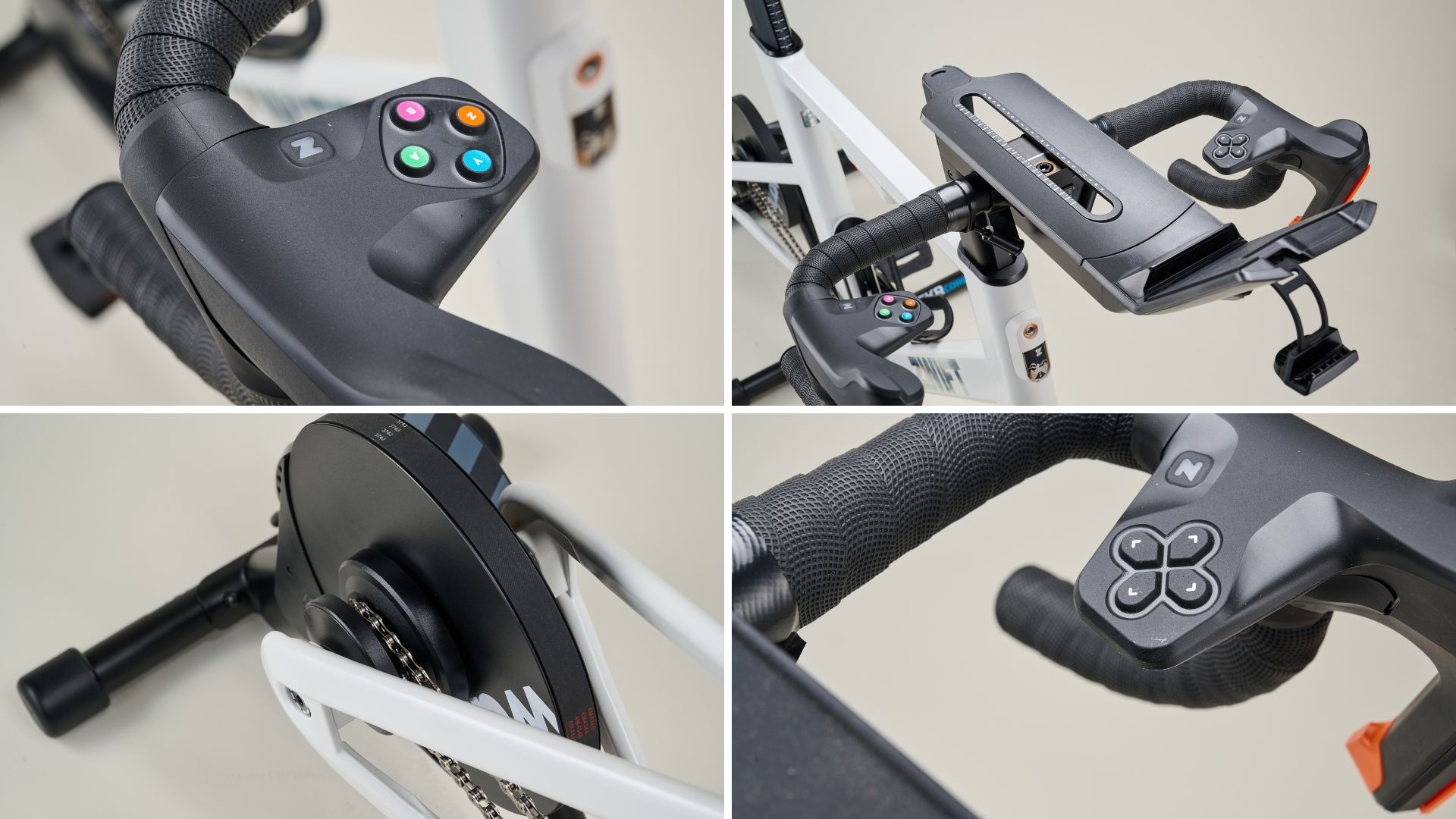
Zwift Ride features buttons designed to work specifically with the app, and its single cog design
Zwift Ride comprises a frameset that attaches to a bundled Wahoo Kickr Core plus a set of basic flat pedals. Currently, you have to buy the compete package but Zwift says it plans to sell a frameset-only version from the autumn. We don’t yet know which other trainers will be compatible with the frameset but Zwift tells us that it’s working with the 'usual suspects'.
Tech Specs
Frameset Specs
Price: £1,199.99/$1,299.99
Weight: 17kg
Controller battery life: 20 hours
Drivetrain: Zwift Cog with 9 speed chain
Frame finish: White. Powder Coated
Frame material: Steel
Crank length: 170mm
Bar width: 42cm
Wahoo Kickr Core Specs
Maximum Power Output: 1800 Watts
Maximum Simulated Grade: 16%
Minimum Simulated Grade: -10%
Product Weight: 40 lb / 18 kg
Drivetrain: Belt Drive
Resistance Type: Electromagnetic
Power Accuracy: +/-2%
Connectivity: ANT+, ANT+ FE-C, and up to three Bluetooth Connections
It’s beyond the scope of this piece to include a complete review of the Wahoo Kickr Core but suffice to say that it’s a decent quality mid-level smart trainer. You can find a comprehensive review here, including everything you need to know about the Zwift Cog too.
Integrated into the handlebars are a pair of satellite controllers that provide features identical to Zwift’s bolt-on Play product, but the aesthetic and ergonomics are much improved. In a nutshell, these controllers, together with additional buttons on the levers, enable you to change gear, brake, steer and control various elements of Zwift including navigating the interface, giving Ride Ons and claiming PowerUps - all things that ordinarily demand pressing keys on a nearby laptop.
Zwift says its product development team has made Ride as easy to use and as easy to live with as possible, with a focus on ‘multi-user, multi-occupancy households’. In other words, if you’re blessed with a partner who’s also a cyclist then they’ll want to have a go too, so it had better be easy to swap riding setups on the fly. Conversely, you may be saddled with a partner who believes you already own too many bikes and cannot understand why, for the love of God, you want to ride one indoors. In both cases Zwift has you covered.
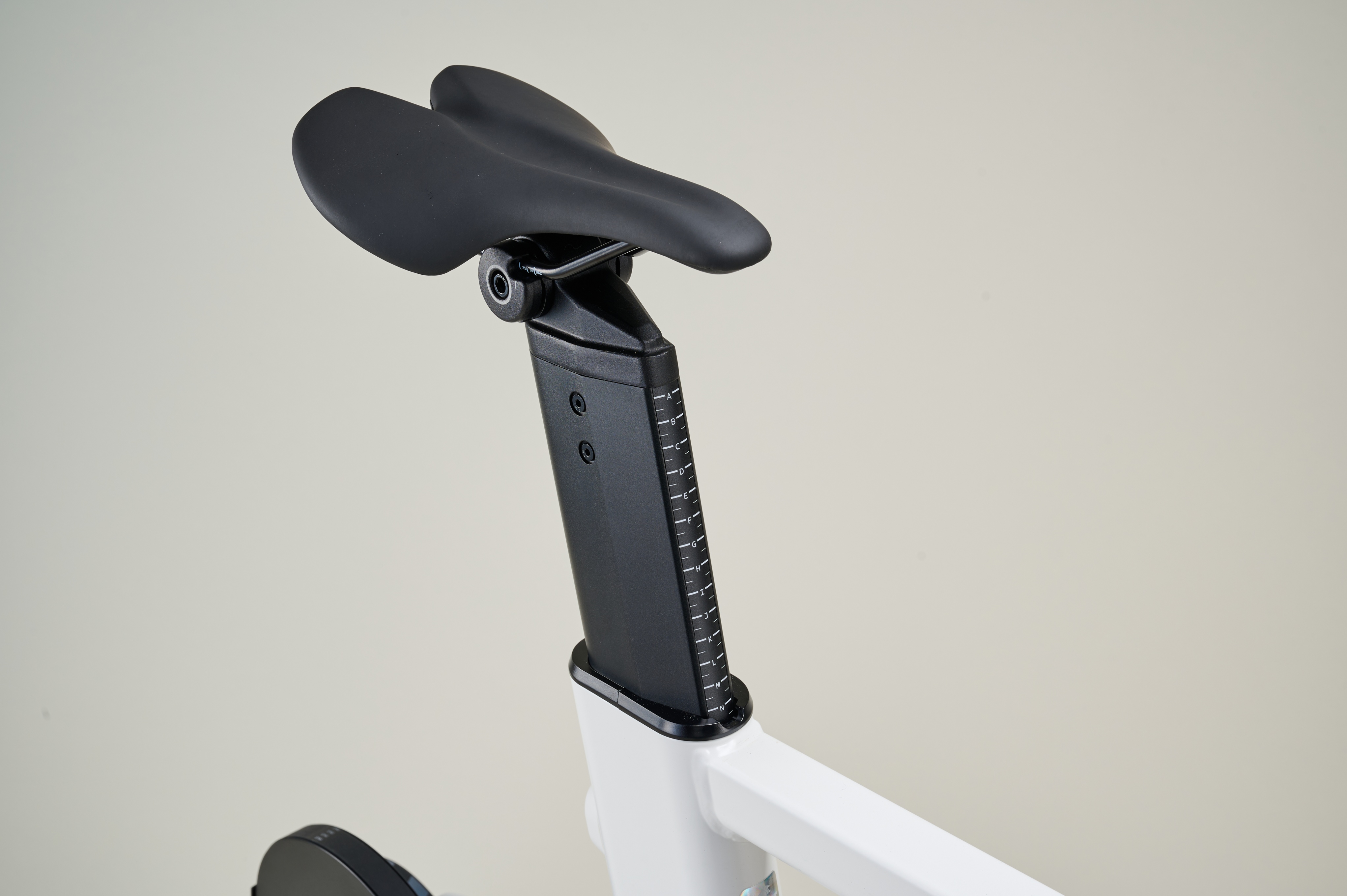
Zwift has placed a focus on ‘multi-user, multi-occupancy households’
Dialling in personalised setups for multiple users really couldn’t be any easier. The frameset has just three adjustment points – saddle height, stack and reach – set by tightening bolts at the seat tube, head tube and ‘stem’ with a 6mm hex tool. The supplied pedals also take a 6mm hex, as does the thu-axle that attaches the frame to the Kickr Core. Conveniently, Zwift includes one that neatly stows in a magnetic housing beneath the top tube, presumably to stop it from wandering off to complete other household duties, never to be seen again.
Rather have to best-guess your saddle height and other bike fit credentials, a daunting prospect for many beginners, Zwift has provided a handy table that simplifies these parameters based on height. Find your height on the supplied bike fit card, then read across to discover a single corresponding letter. For example, if you’re 5’10” the letter will be N. Set all three adjustment points to N from a sliding scale of hatch marks and, hey presto, the Zwift Ride should fit perfectly.

Lettered fit points make set up easy on the Zwift Ride
Even if your loved ones hate the prospect of having an exercise bike in the house they may warm to the prospect of allowing the Zwift Ride over the threshold. Relatively compact, and painted neutral white with a subtle, silver iridescent metallic logo (yep, that does sound like a contradiction but it’s largely true), it blends into the background better than most.
Better still, it’s remarkably easy to break down, ready to be stored out of sight. The marriage of separate trainer and frame - let’s be kind and call it modular - can be disassembled in less than five minutes, including the removal of the handlebars. With the Kickr Core weighing in at 18kg and the frameset a kilo less, both are light enough to move around the house without troubling an osteopath.
Zwift Ride, the setup
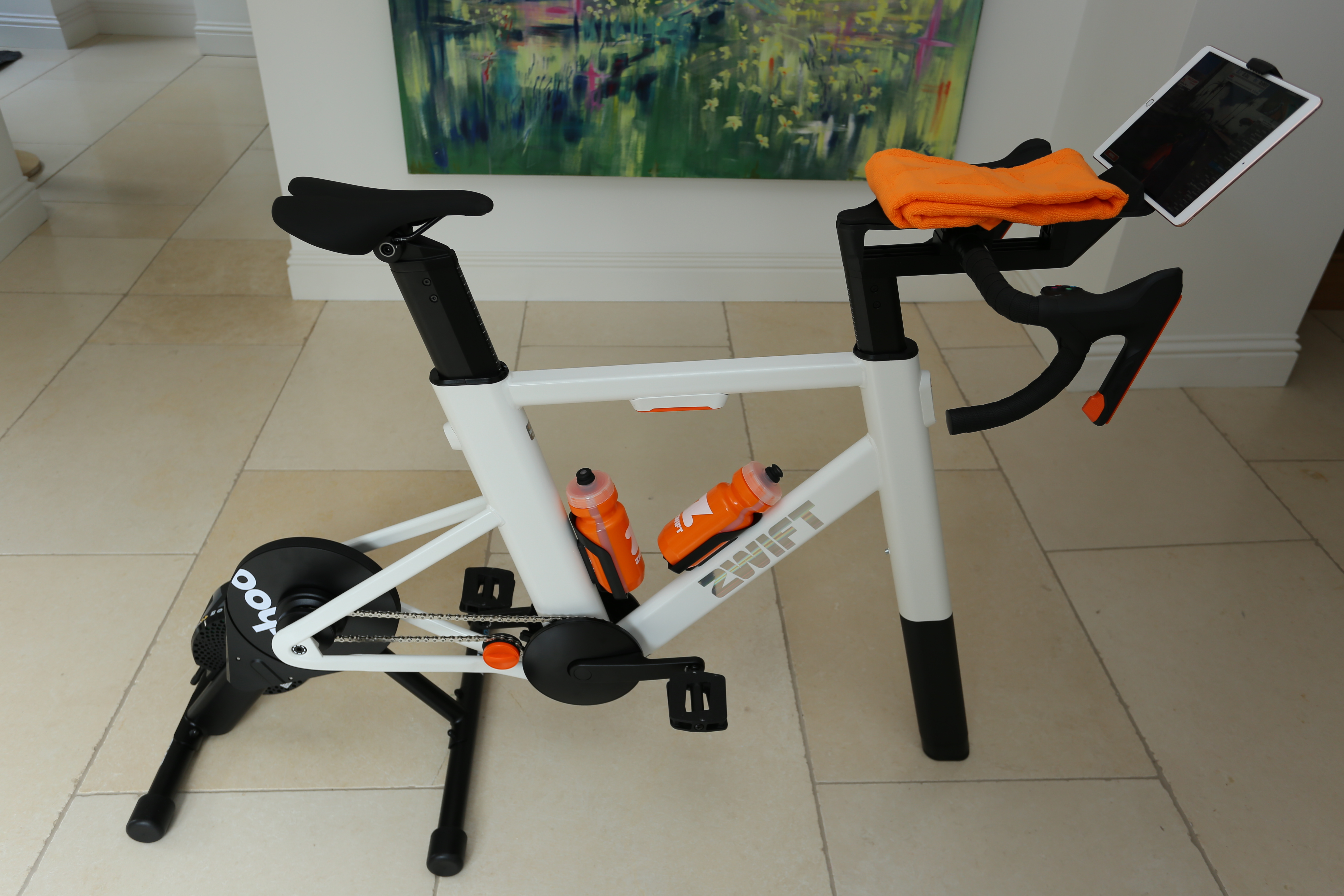
The Zwift Ride set up and ready in Simon's home
My experience with Zwift Ride started with a knock at the door announcing the delivery of three large packages. Zwift says that shipping a trio of boxes is more manageable for consumers and reduces delivery costs, which will be £50 for UK customers.
The largest box contains the frameset, with the Kicker Core in the second largest and handlebars, pedals and other components in the smallest. Assembling this smart bike really is quick and easy. The Wahoo trainer just needs its feet bolting on before the frameset, which ships with chainset, chain, saddle and stem in situ, can be quite literally dropped on.
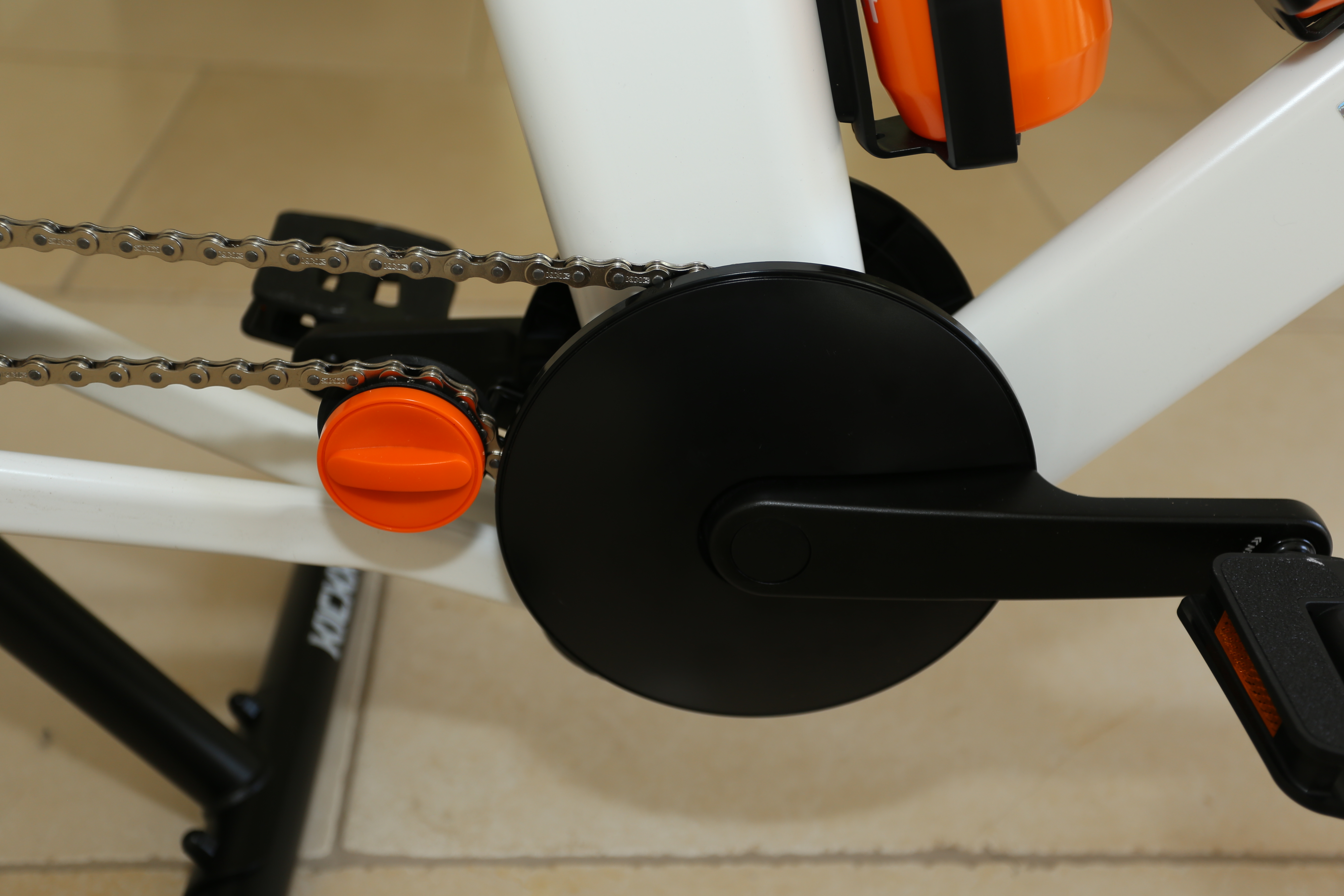
A chainhook allows the frame to be stowed when not on the trainer
The interface between the two is very impressive. The driveside dropout includes a chain hook that enables the chain to be stowed when the frame isn’t installed on the trainer. This lifts it clear of the ground, so it won’t mark precious carpets if you rest the frameset down for a moment - also facilitated by a rubber foot that sits beneath the bottom bracket area.
To mount the frameset on the trainer you just line up the dropout housings with the hub spacers and you’re almost done. Secure the union with the thru-axle, release the chain tensioner with a flick, slide the chain from its hook to the single sprocket, flick the chain tensioner back on, thread on the pedals (a label on the cranks shows which way they tighten) and that’s the drivetrain sorted.
Sliding the handlebars onto the tracks in the stem area can be a bit fiddly, but it doesn’t take more than a couple of attempts. The bars are held in place by a simple end cap, or in my case a tablet holder. Both cap and holder are retained by a single bolt and a thick silicone pad covers up the stem adjustment area, providing you with a neat tabletop on which to place a towel or your phone.
According to Zwift’s bike fit calculations I’m a T, a setting that put me in a ‘comfort/endurance’ position with the bars level with the saddle. Saddle height and reach were pretty much spot on, but I decided to drop the bars a bit to more closely replicate the feel of my road bike. You don’t have to follow Zwift’s recommendations, if you want to increase the reach and decrease the stack for ever more aggressive stances then that’s up to you. For novices though, Zwift’s single letter solution works surprisingly well.
Bar width is wide at 42cm and crank length errs on the long side at 170mm. Neither of these components can be adjusted, which is likely to be an issue for shorter riders who already have a pre-defined bike fit which they want to stick to. Beginners may not mind so much, but the set-up is unlikely to be optimal. I found the saddle, which is an unbranded short-nosed model, remarkably comfortable and I suspect most users will too. If not, it can easily be swapped out, as can the pedals.
Powering up the Ride does betray its origins as a hodgepodge of different components and systems. Before you get going you’ll need to install Wahoo’s app to register the Kickr Core, and download any firmware updates.
Then, after switching on the satellite Bluetooth handlebar controllers individually, you’ll have to connect everything up to Zwift’s app, which in my case was running on an iPad Air. Subsequent sessions only require the trainer and satellite controllers to be turned on – they’ll automatically connect to the Zwift app – but it would be handy to have a single button that powers up everything.
The bar controllers are powered by rechargeable batteries with a claimed life of approx 20 hours, which for many of us will be two to three weeks of use. It’s early days, but mine are still going strong on their original charge. Each controller has to be charged individually, but fortunately Zwift supplies a USB Y cable so they can suck juice from the same source.
Zwift Ride, the ride
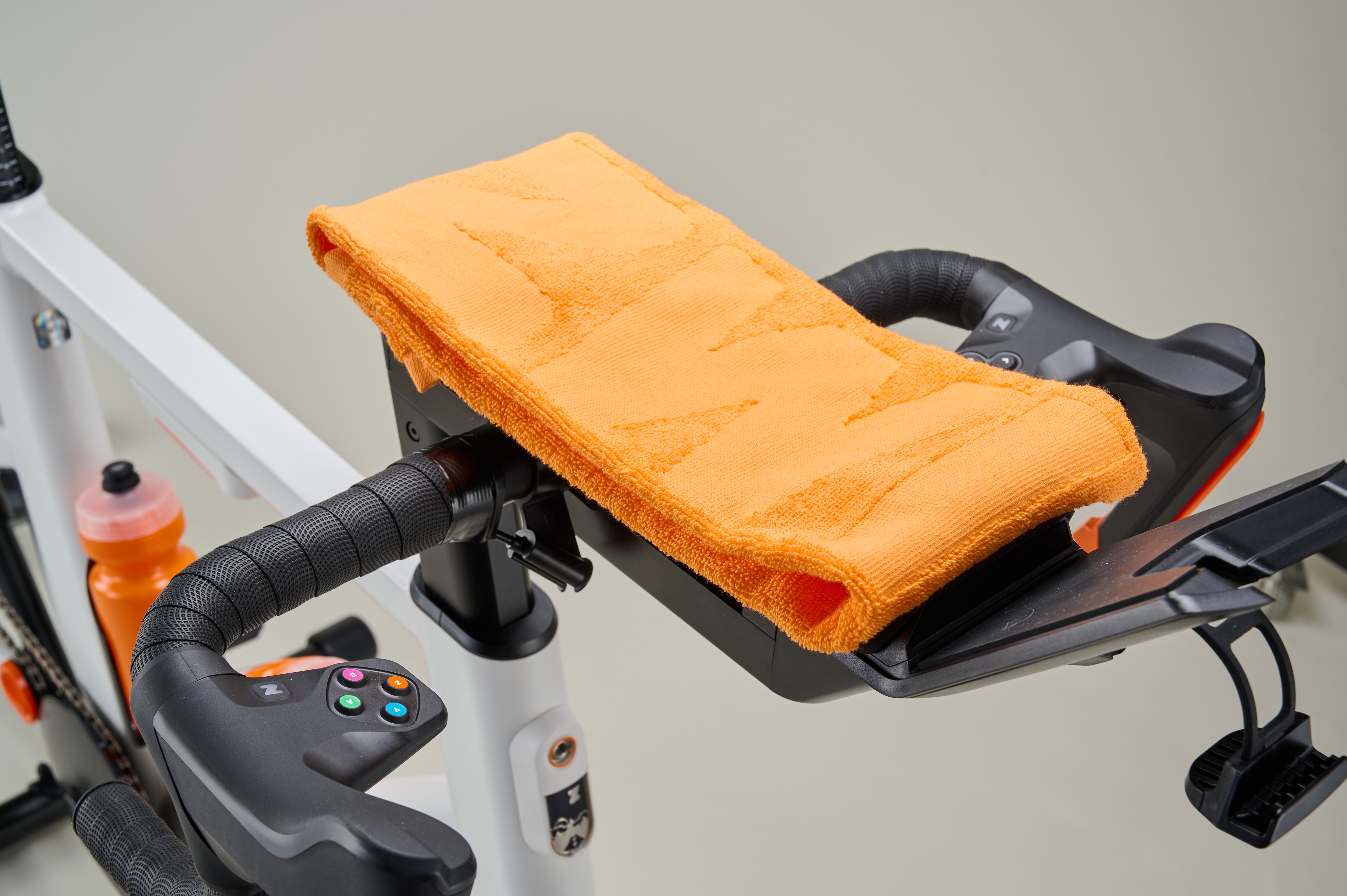
Don't forget the orange towel!
The Zwift platform aside, three qualities stand out when riding the Ride. Firstly, that slender front leg, which doesn’t look particularly stable, positively adds to the ride feel. I’ve ridden smart bikes in the past that feel completely rigid, locked down. This isn’t one of them, especially when you put some power through the pedals. The movement that’s generated always feels stable and safe, but it is there and I, for one, prefer it. Of course, the legs on the Kickr Core influence this too, so swapping to a different trainer in the future will likely change the feel.
Secondly, the Ride is very quiet, thanks to the single Zwift Cog on the Kickr Core. Of course, my sample Ride came with a freshly factory-greased 9-speed chain installed on a brand-new drivetrain, but even so, it’s impressive how little noise the Ride generates.
Thirdly, the performance and convenience of Zwift’s virtual gearing is now superb. The release of Ride coincides with a host of improvements to virtual gearing, including the option to choose between SRAM- or Shimano-style 2x12 shifting, and program the buttons on the Ride’s ‘levers’ accordingly. Virtual gear ratios have been tweaked to offer setups for three different terrain types too. For flat routes you can choose 53/39 upfront and a 10-28 cassette, for the middle ground you can take a 48/35 with a 10-33, and for full-on climbing routes there’s 43/10 with 10-36.
All this with the convenience, low-running costs and quietness of a single cog with a 9-speed chain.
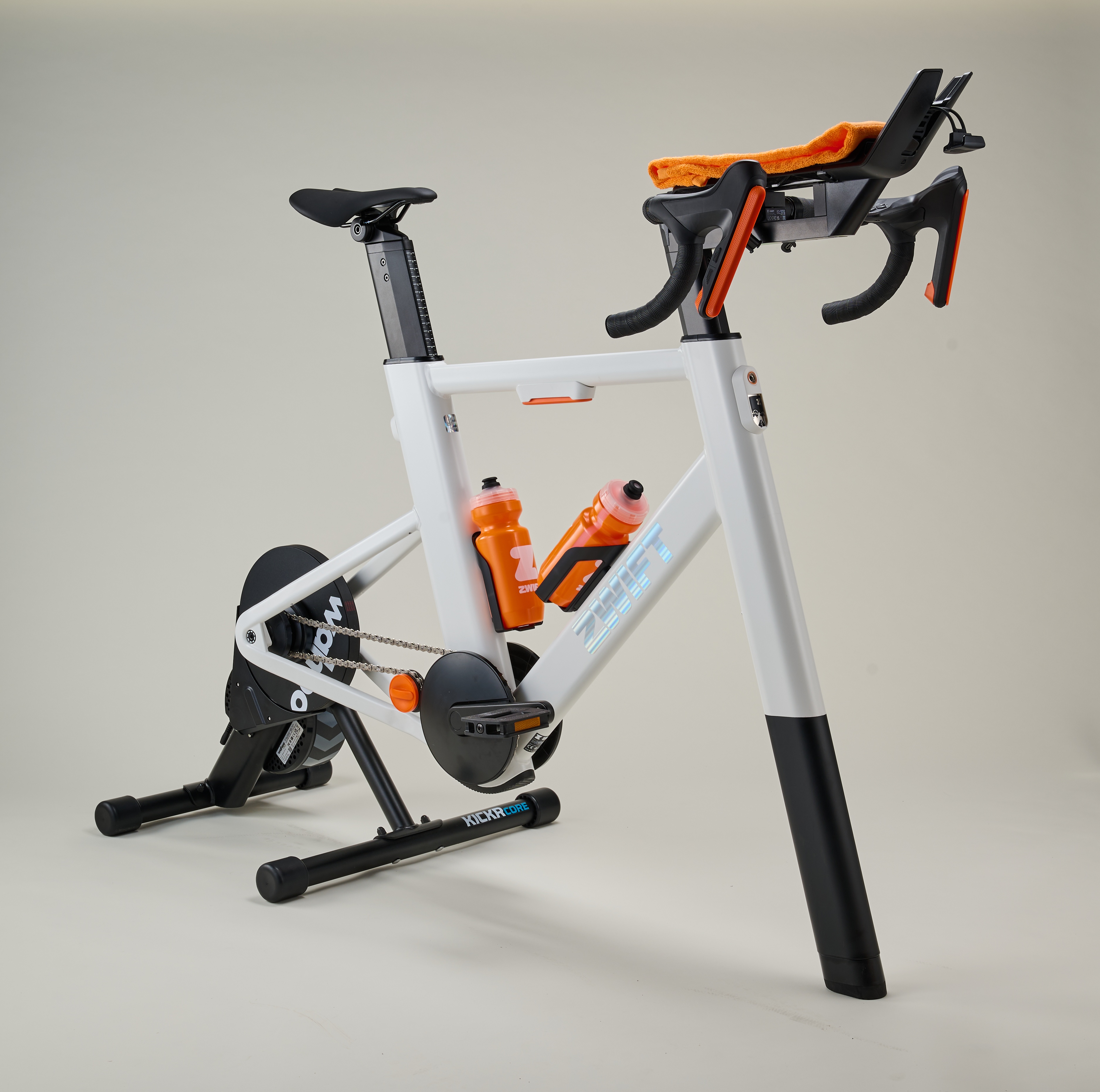
Back to the ‘levers', it’s already possible to configure buttons for Ride Ons and Power Ups, with the promise of Camera Look Back coming soon. Zwift tells us that it’s working on more user-configurable options for these buttons, to enable riders more interaction with the platform and fellow Zwifters, yet with fewer distractions.
Is there anything I would change? Yes, I found the bar tape too thin and plasticky, so that’s coming off in favour of something with more cushion and better grip under sweaty hands. I’ll also be substituting the bundled pedals with my favourite clipless set, though I appreciate many beginners feel more at home on flats.
Anything I don’t like? Well, it’s impossible to lift and move an assembled Ride even just a few feet without it pivoting on the thru-axle with an annoying scissor-like action. The 42-centimetre bars and 170mm cranks may also be a compromise too far for smaller riders, or those who are used to a narrower stance at the front.
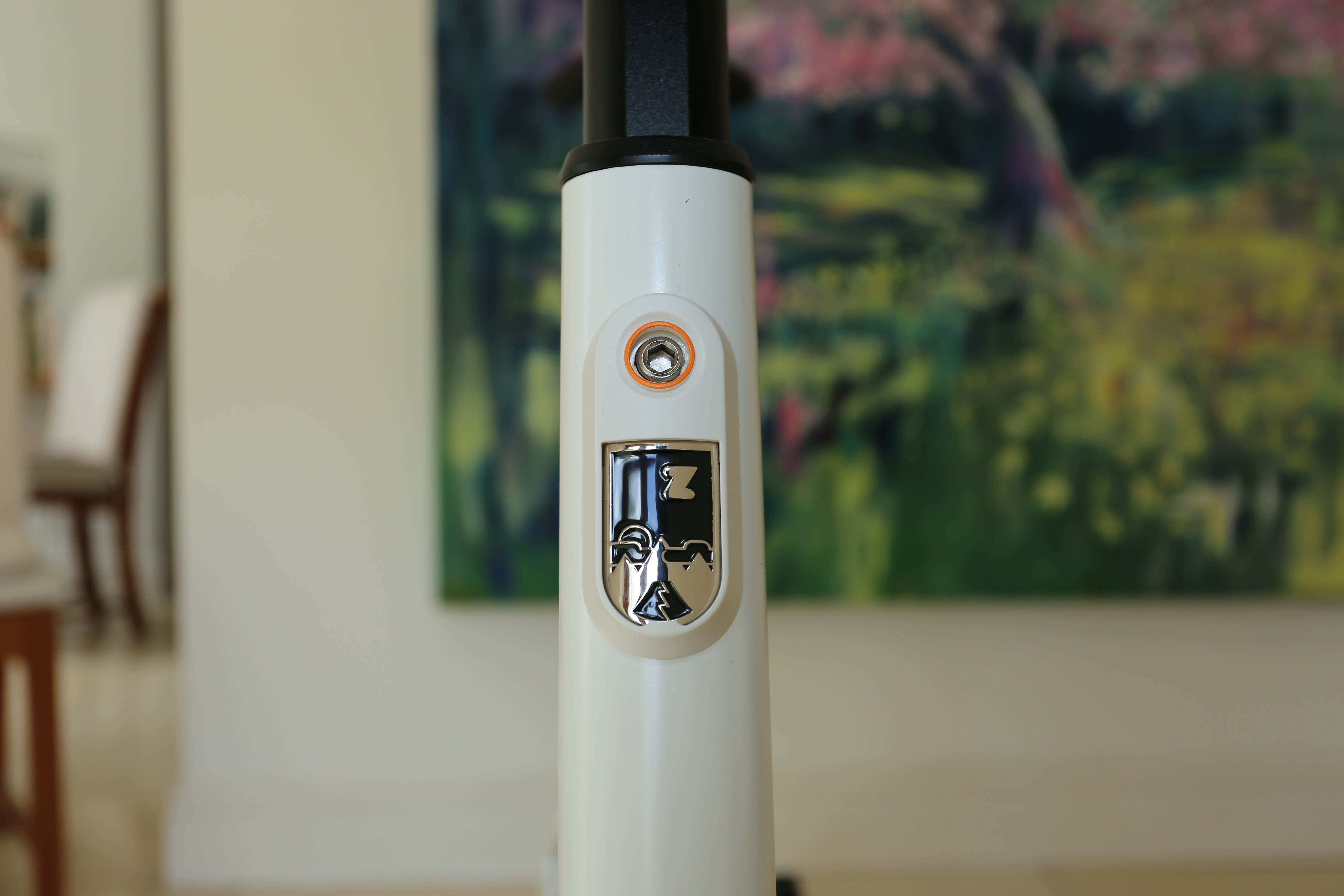
The Zwift Ride Badge of Honour went down a treat with Simon
That said, there’s very little I’d want to see altered on the Ride, certainly nothing that would trigger a price increase. It’s just so well-thought out and convenient to use as it is. I love all the little features - the chain hook, the magnetic hex key housing, the ‘badge of honour’ on the head tube that can be updated to mark your Zwifting achievements, the simple bike fit system, the easy grab bottle cages, the towel table. Then, of course, there are the big things that have existed before but are now brought together in one coherent package – virtual shifting, the single cog, the bar controllers that make using Zwift’s interactive features less heavy-handed and more dextrous.
Zwift Ride: our verdict
It may not be the Zwift Ride that we expected two years ago, but in the meantime Zwift has played smart by pulling its existing tech together into a package that has great appeal. Adding to that allure is the price, which undercuts the competition by a huge margin. Cynics will argue that it’s just a frame on a trainer, but it’s genuinely more than that. For novices intimidated by the complexity and cost of a traditional Zwift setup, the Ride is a no-brainer.

Simon spent his childhood living just a stone’s throw from the foot of Box Hill, so it’s no surprise he acquired a passion for cycling from an early age. He’s still drawn to hilly places, having cycled, climbed or skied his way across the Alps, Pyrenees, Andes, Atlas Mountains and the Watkins range in the Arctic.
Simon now writes for Cycling Weekly as a freelancer, having previously served as Tech Editor. He’s also an advanced (RYT 500) yoga teacher, which further fuels his fascination for the relationship between performance and recovery.
He lives with Jo, his yoga teacher wife, in the heart of the Cotswolds, with two rescue cats, five bikes and way too many yoga mats. He still believes he could have been a contender if only chocolate weren’t so moreish.